Vegan Globetrotter is supported by our audience. When you purchase through one of our links, we may earn a small affiliate commission. As an Amazon Associate I earn from qualifying purchases. Your cost is not affected.
==================
In kitchen safety, induction cooktops have emerged as a revolutionary technology, promising both efficiency and precision and a significant reduction in the risk of kitchen fires. Imagine cooking with a device that heats only the pan and its contents while leaving the surrounding surface cool to the touch.
This article delves into how induction cooktops accomplish this feat and why they are gaining popularity among safety-conscious chefs and homeowners. Discover how this kitchen equipment can elevate your culinary journey while prioritizing kitchen safety.
Induction Cooktops: Reducing the Risk of Kitchen Fires Through Advanced Safety Features

Kitchen safety is a top priority for homeowners and chefs alike. Traditional gas and electric stoves can pose risks, such as gas leaks or electrical malfunctions, leading to kitchen fires. That’s where induction cooktops come in. They use electromagnetic technology to heat your cookware directly rather than the entire cooking surface.
This significantly reduces the risk of fires. Induction cooktops prioritize safety in their design. They often have features like automatic shutoff and child lock systems to prevent accidents. Plus, the precise temperature control they offer not only makes cooking safer but also improves culinary results. If you’re concerned about kitchen safety, switching to induction cooktops could be smart. They’re a great way to prevent fires and make your kitchen safer.
Key Takeaways
- Induction cooktops utilize electromagnetic technology to heat cookware directly, thereby lowering the risk of fire. They also include built-in safety features and precise temperature control for added safety.
- Ensure safety, from selecting proper cookware to mastering cooking techniques. Quick and correct responses during kitchen accidents can prevent further damage and ensure safety.
- Induction cooktops have advanced significantly in safety, reducing kitchen fire risks through innovative features and smart technology. Professional installation and services are crucial for safety and efficiency in the kitchen.
- Regulatory standards and certifications are crucial for ensuring the safety and reliability of induction cooktops.
- Educating the public about the safety benefits of induction cooktops is essential for reducing kitchen fires. Consumer awareness and education about the technology can significantly impact its adoption and safe usage.

The Basics of Induction Cooktop Technology
Induction cooktop technology offers a unique cooking method vastly different from conventional gas or electric stovetops. By using electromagnetic energy, these cooktops tackle the kitchen’s need for safety and efficiency.

Understanding Induction Heating
Induction cooktops harness an electromagnetic field to heat pots and pans directly. This method transfers energy straight to the cookware, causing it to become the heating element.
The process begins when an alternating current passes through a copper coil beneath the cooktop’s ceramic surface, creating a dynamic magnetic field.
Key Components and How They Work
The primary components of an induction cooktop include:
- Copper Coil: Conducts electromagnetic energy to interact with magnetic cookware.
- Ceramic Plate: Serves as the durable, easy-to-clean surface of the cooktop.
- Control Interface: Allows precise temperature and cooking control.
- Pan Detection: Ensures energy is only expended when suitable cookware is present.
These elements collaborate to achieve rapid heating and unparalleled control, with the cooktop remaining cool to the touch. This technology improves safety by reducing the risk of burns and enhances energy efficiency as less heat is lost to the surrounding environment.

Did You Know?
Induction cooktops heat your pans directly, so they heat up much faster. You’ll notice this especially when boiling water—it happens much quicker than gas or electric stoves.
Advantages of Induction Cooktops in Fire Prevention

Induction cooktops bring significant fire prevention advantages to the kitchen, primarily through features like precise temperature control, the absence of open flames, and innovative safety characteristics.
Temperature Control Precision
Induction cooktops offer unprecedented precision in temperature control, a crucial factor in fire prevention. They are capable of rapid adjustments to heat levels, providing an immediate response when a reduction in temperature is needed to prevent overheating and potential ignition of cooking materials.
No Open Flames
By design, induction cooktops operate without open flames, eliminating one of the main hazards that can lead to kitchen fires. This characteristic makes them considerably safer than their gas and electric coil counterparts, as the risk of accidental ignition of flammable materials is drastically reduced.
Safety Features Unique to Induction
Induction technology incorporates various safety features that contribute to fire prevention. These may include:
- Automatic Shutdown: If a pot is removed or no activity is detected for a period, the cooktop will turn off.
- Overheat Protection: Sensors detect excessive temperatures and can cut power to prevent burn accidents and fire risks.
- Pan Recognition: Only heat the area under the cookware; the rest of the surface remains cool, reducing fire danger.
Innovations in Induction Cooking Safety
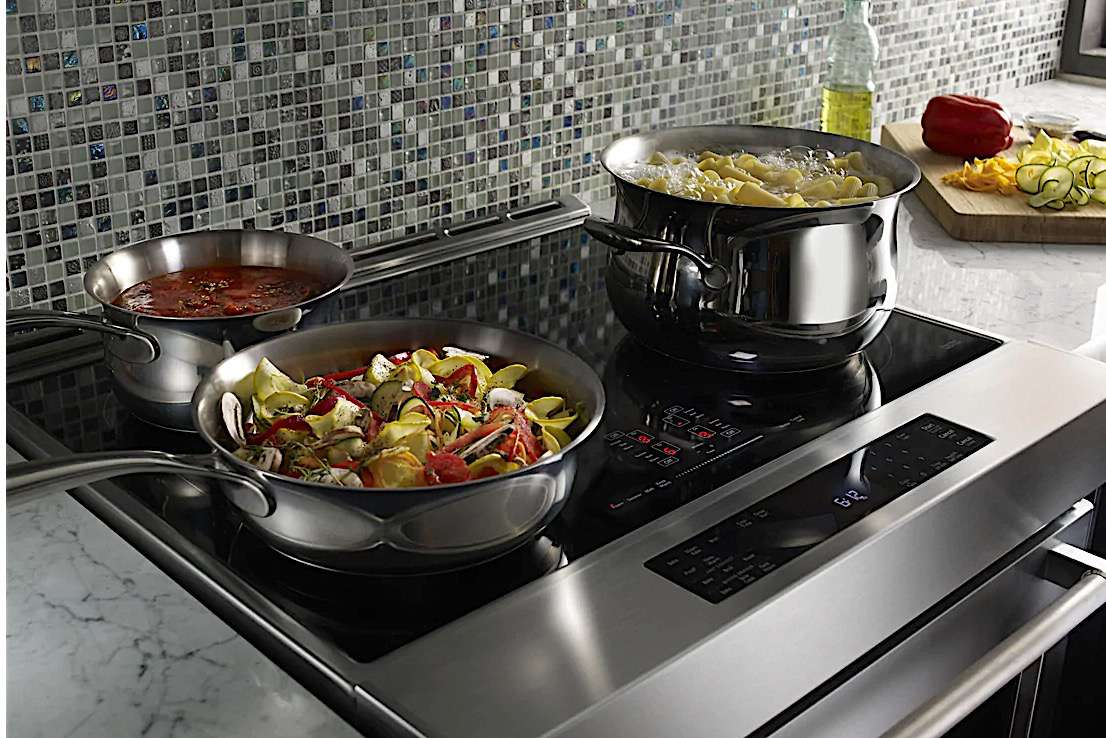
Induction cooktops have seen significant safety advancements, effectively reducing the risk of kitchen fires through innovative features and smart technology integration.
Improved Safety Features
Induction cooktops are important when it comes to safety. Unlike traditional cooktops, they’ve got all these clever safety features built right in. First, they keep their surface cool to the touch so you won’t accidentally burn yourself. That’s a big plus, especially if you’ve got little ones running around. And get this—they only heat the cookware itself, not the surrounding surface.
So, you can have peace of mind knowing that the risk of accidents is way lower. But wait, there’s more! A lot of these models also come with automatic shutoff systems. They kick in when you take the pot off or if there’s no activity for a while. That’s like an extra layer of protection against overheating mishaps in the kitchen. So, if you’re all about safety and want to cook with less worry, these induction cooktops might be the way to go.
Smart Technology Integration
With smart technology, induction cooktops have taken safety to a whole new level. For instance, they have a child lock feature that prevents unintended activation, keeping minors safe. Because induction cooktops don’t use open flames and produce very little radiant heat, they significantly reduce the risk of fires caused by contact with flammable materials.
Some advanced models even have spill-detection technology. The cooktop automatically shuts off if a spill occurs to prevent burns or potential fires. And now, with connectivity features, users can monitor and control their cooktop remotely. This means you can turn off the cooktop even when you’re not home, adding a layer of safety and convenience.
Comparative Analysis of Cooktop Fire Risk
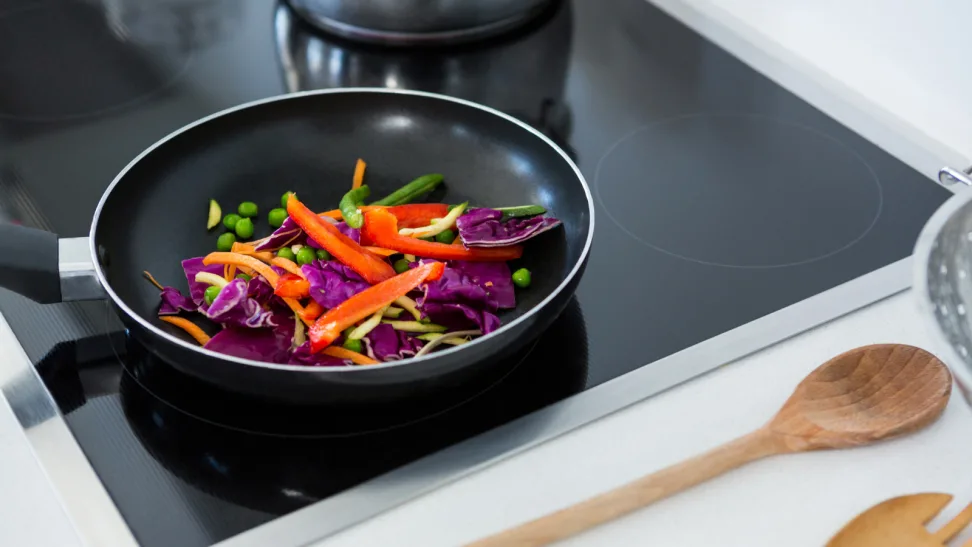
Let’s discuss why induction cooktops are getting so much attention in kitchen safety discussions. They’re designed to minimize fire risks, which is a big deal. Here, we’ll compare induction cooktops with traditional gas and electric ones to see how they compare when it comes to causing kitchen fires.
Induction Vs. Gas Cooktops
Induction cooktops utilize electromagnetic fields to heat cookware, offering a significant safety advantage over gas cooktops. Gas cooktops using an open flame inherently present a higher risk for direct fire incidents. Induction technology does not involve an open flame, which reduces the odds of ignitable materials such as cooking oils catching fire from direct contact.
Additionally, induction cooktops typically feature automatic shutdown mechanisms, which lower fire risk, as heating is stopped when no compatible cookware is detected on the surface.
Induction Vs. Electric Cooktops
Induction cooktops are much safer than traditional electric cooktops when it comes to fire risks. Statistics show electric cooktops are more prone to fires, especially when used improperly. Electric cooktops retain heat longer, so there’s a risk even after you turn them off. But here’s where induction cooktops shine: they only heat up the pan on them, using special induction-compatible cookware.
So, the cooking surface itself stays cool to the touch. Another safety bonus is how quickly you can adjust the temperature with induction cooktops. That precise control can prevent overheating and lower the chance of anything catching fire in your kitchen.
Best Practices for Induction Cooktop Use
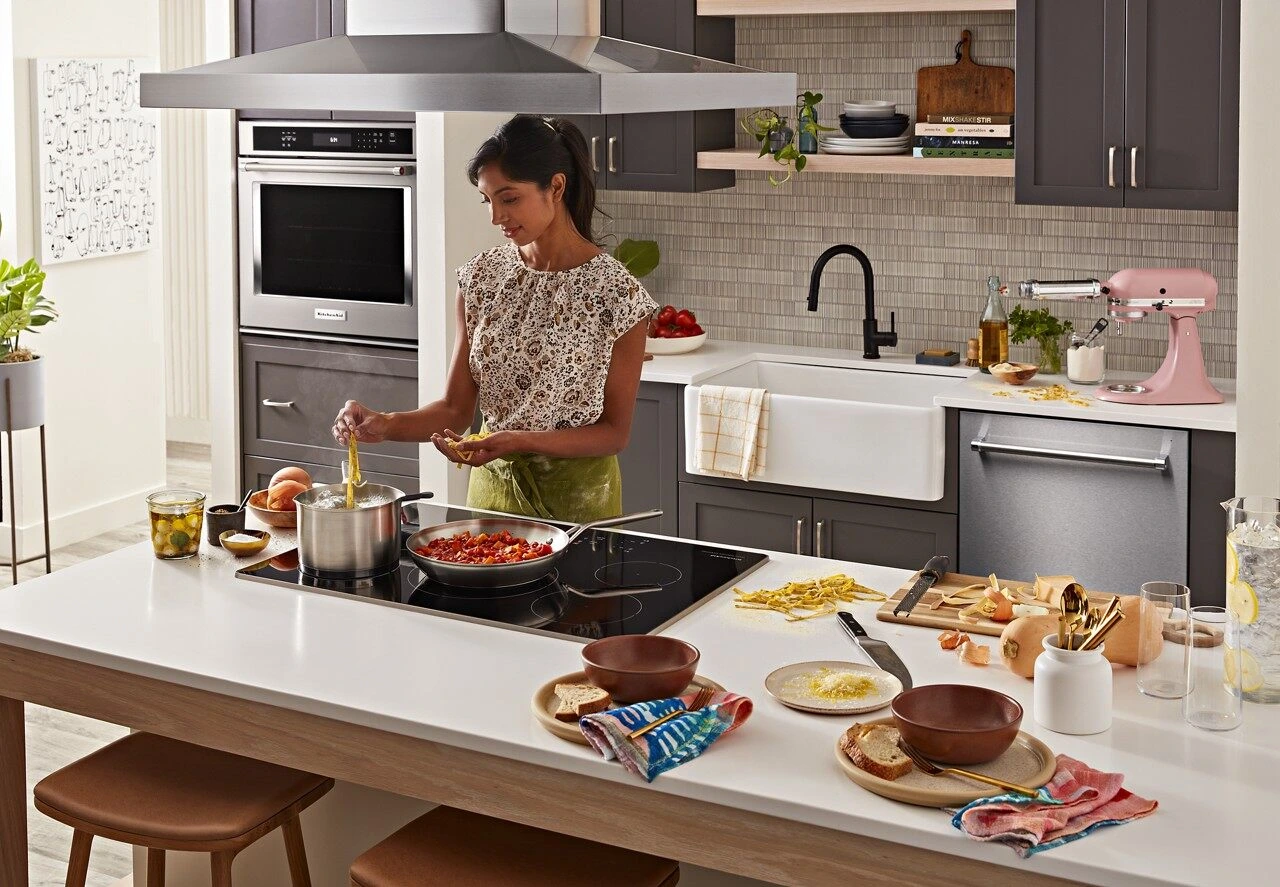
Users should adhere to certain practices to maximize the benefits of induction cooktops and ensure safety. These include choosing appropriate cookware, maintaining the cooktop, and applying effective cooking techniques.
Proper Cookware Selection
So, with induction cooktops, you need pots and pans that are magnetic. That means they should have flat bottoms and be made of metals like cast iron or stainless steel.
Maintenance and Cleaning
Keeping an induction cooktop clean is crucial not only for appearance but also for performance. After each use, the surface should be wiped down with a soft cloth to avoid scratching the glass. Users should wait until the cooktop cools down for spilled food and then use a dedicated ceramic cooktop cleaner to avoid damage.
Cooking Techniques
These cooktops benefit from precise temperature control, so users can achieve desired cooking results by accurately setting the temperature. Furthermore, since the cooktop surface doesn’t get hot, there’s a reduced risk of burns from touching the stovetop area. Still, users should carefully handle the cookware as it gets very hot.
Here’s an additional video explaining why chefs love cooking with induction.
By: Reviewed
Emergency Handling and First Aid
Swift and correct responses can prevent further damage and ensure safety in kitchen accidents. This section outlines crucial steps for handling overheated cookware, administering first aid for burns, and recognizing when to call emergency services.
Dealing with Overheated Cookware
When cookware overheats on an induction cooktop, avoiding direct contact with the hot surface is essential. Use oven mitts or a dry cloth to remove the cookware from the cooktop.
If you notice smoke, immediately turn off the cooktop and cover the pan with a lid to suppress any potential flames. Never use water on oil fires, as this can cause a dangerous splatter or spread the flame.
First Aid for Burns
If a burn occurs, immediately cool the area with cool running water for at least 15 minutes to reduce inflammation and alleviate pain.
Once the burn has cooled down, it’s important to cover it with a sterile bandage that doesn’t stick to the skin. This helps protect the burn from getting infected. Consider using aloe vera or burn ointment for minor burns to soothe the burn.
- Do not apply ice, as this can further damage the skin.
- Do not pop blisters or remove peeling skin.
- Do not apply butter, oils, or other home remedies, as they can trap heat and increase the risk of infection.
When to Contact Emergency Services
Contact emergency services immediately if the burn is extensive, covers the hands, feet, face, groin, buttocks, or a major joint, or if charring or white discoloration is visible.
Additionally, if the person has difficulty breathing or shows signs of shock, such as faintness or weakness, call for help without delay. Time is of the essence in these situations to prevent complications and ensure proper care is administered.
Installation and Professional Services
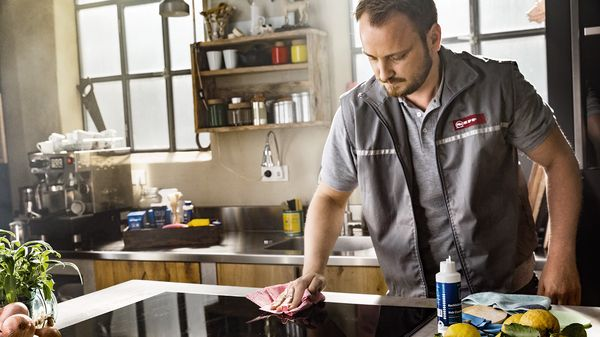
Proper selection, expert installation, and regular maintenance are pivotal to maximizing the benefits of induction cooking.
Choosing the Right Induction Cooktop
When selecting an induction cooktop, customers should consider various factors such as size, power level, and additional safety features. Options might include built-in safety features like automatic switches and child lock systems to prevent accidents.
Professional Installation
Once a suitable cooktop is chosen, it is crucial to enlist a certified professional for installation services. Professionals will manage the correct electrical specifications and ensure the installation meets safety standards. This is crucial to prevent electrical issues and improper use that may pose safety risks.
Ongoing Professional Maintenance
To sustain the safety and performance of induction cooktops, ongoing professional maintenance is advised. Regular check-ups by a certified technician can help prevent potential issues and ensure the cooktop functions optimally. This maintenance includes checking the electromagnetic fields and ensuring the cookware sensors are in good working order.
Regulatory Standards and Certifications
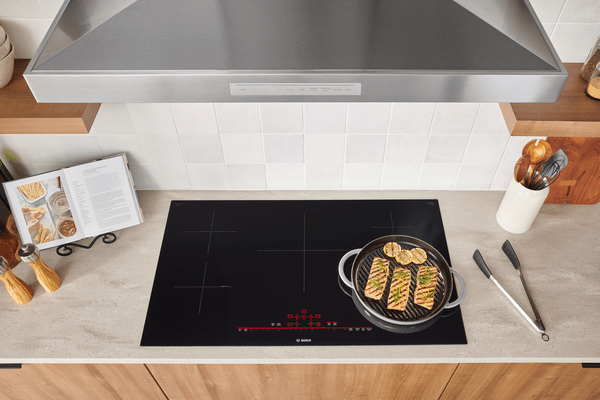
Regarding induction cooktops, regulatory standards, and certifications are vital for ensuring your safety and the product’s reliability. These benchmarks safeguard against fire hazards in your kitchen.
Consumer Safety Standards
Induction cooktops are designed with consumer safety in mind, aiming to minimize the risk of burns, fires, and other safety concerns. One notable standard is the ENERGY STAR Commercial Electric Cooktop Version 1.0, which promotes efficiency and ensures user safety through comprehensive guidelines.
These standards emphasize that induction cooktops heat cookware directly, significantly reducing the risk of burns and kitchen fires.

Certification Processes
The certification process for induction cooktops involves a series of testing and evaluation procedures to verify adherence to safety standards.
This typically includes:
- Electrical safety tests to ensure that the cooktops are free from electrical hazards.
- Performance checks that affirm the cooktops’ ability to cook effectively with reduced energy consumption.
- Safety feature assessments, such as automatic shutoffs and child lock systems, aim to prevent accidental scalds or burns.
Manufacturers must demonstrate compliance with safety regulations through these processes to obtain certifications like UL listing or CE marking. These certifications signal to consumers and retailers that the cooktop is trustworthy and has passed stringent safety testing.
Consumer Awareness and Education
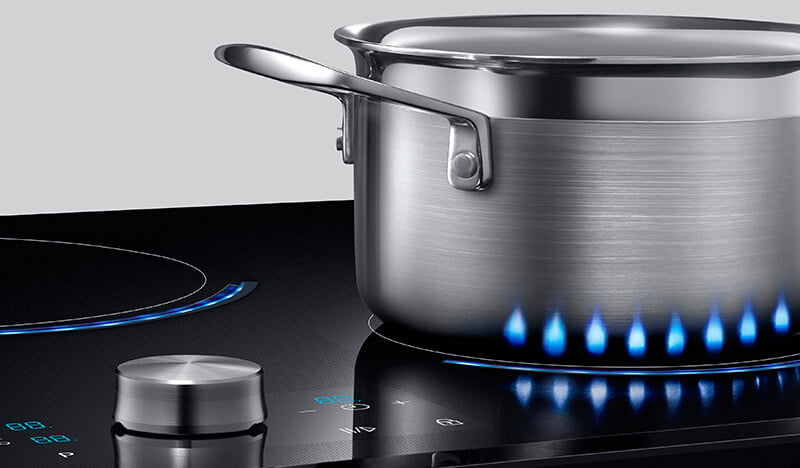
Educating the public on the safety benefits of induction cooktops is essential in reducing kitchen fires. Consumer awareness and education about the technology can significantly impact its adoption and safe usage.
Educational Resources for Safe Use
Consumers need educational resources that guide them on safely using induction cooktops.
Such resources include:
- User Manuals: Detailed guides on the operation of induction cooktops ensure users are fully informed on how to use them safely.
- Cooking Classes: Hands-on classes can help people learn cooking techniques for induction cooktops.
- Online Videos and Articles: Websites dedicated to induction cooking safety, like Consumer Reports, provide visual and written materials that can be easily shared and accessed to promote safe practices.
Here’s a video discussing the pros and cons if you’re considering owning an induction cooktop.
By: Boulevard Home
Induction Cooktops – Revolutionizing Kitchen Safety
Induction cooktops represent a leap forward in kitchen safety, offering efficiency, precision, and a significantly reduced risk of kitchen fires. These cooktops mitigate the dangers associated with traditional gas and electric stoves by heating only the pan and its contents while keeping the surrounding surface cool to the touch. This advanced technology transforms how we cook and enhances safety for chefs and homeowners alike.

As more people become aware of the benefits of induction cooktops, their popularity continues to grow. With features like automatic shutoff and precise temperature control, induction cooktops are a smart choice for anyone concerned about kitchen safety. Whether upgrading your kitchen or looking for a safer way to cook, induction cooktops offer a reliable solution that can help prevent accidents and fires. Embrace this innovation and enjoy a safer, more efficient cooking experience in your home.
Frequently Asked Questions
How Do Induction Cooktops Reduce the Risk of Kitchen Fires Compared to Other Stove Types?
Induction cooktops offer a distinctive advantage in fire prevention because they use electromagnetic fields to heat cookware directly rather than creating a general heat source. This technology eliminates open flames and reduces uncontrolled hot surfaces that can ignite flammable materials.
Can Switching to an Induction Cooktop From a Gas Stove Lead to Cost Savings in the Long Term?
Over time, induction cooktops’ energy efficiency and reduced heat waste can lower utility bills. Precision cooking can also reduce overcooking and food waste, potentially contributing to cost savings.
How Do Induction Cooktops Perform in Terms of Eco-friendliness Compared to Traditional Electric or Gas Stoves?
Induction cooktops perform more eco-friendly, losing significantly less energy to the surrounding environment. This results in less energy required for cooking and, therefore, a smaller carbon footprint than electric or gas stoves.
Find Us on Social Media
Facebook: VeganGlobetrotter Join us on our Facebook page, VeganGlobetrotter, where we share mouthwatering plant-based recipes and tips to inspire your vegan lifestyle.
Instagram: _veganglobetrotter Follow us on Instagram at _veganglobetrotter to embark on a visual journey of delectable vegan dishes.
Pinterest: theveganglobetrotter Dive into the world of plant-based goodness and wellness with our Pinterest account, theveganglobetrotter.
Twitter: VeganGlobetrot Stay up-to-date with the latest vegan trends, insightful articles, and exciting updates by following us on Twitter at VeganGlobetrot.

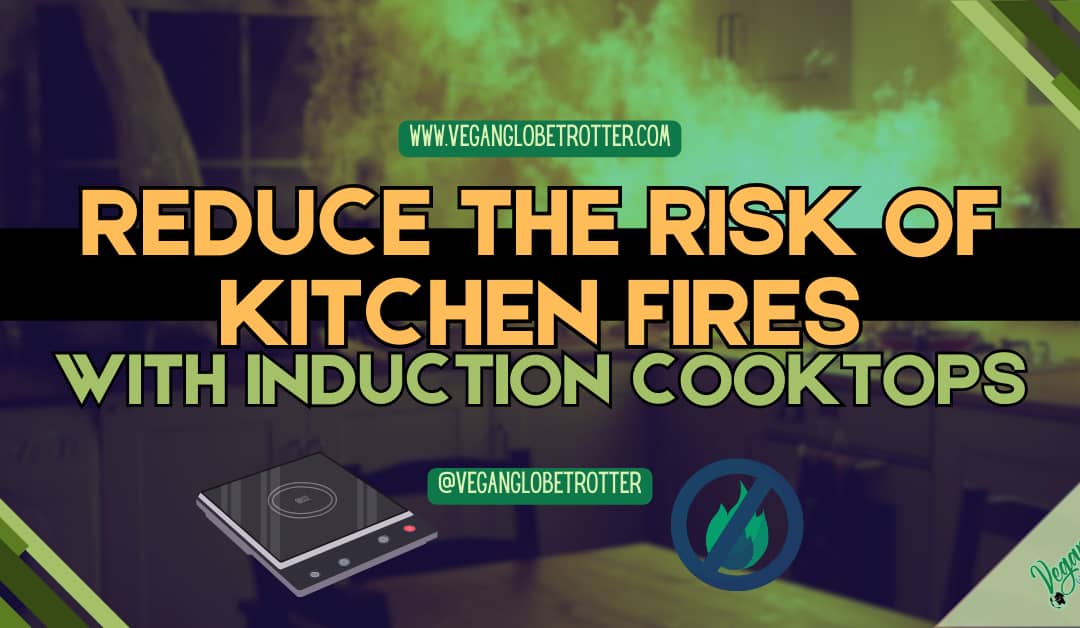



Don't miss out
when new recipes and information are added!
Join our newsletter for free recipes,
healthy living inspiration, and special offers
You have Successfully Subscribed!